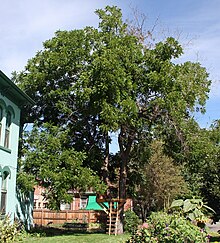Thousand cankers disease
| Thousand cankers disease | |
|---|---|

A walnut tree in Denver, Colorado affected by Thousand cankers disease.
|
|
| Common names | TCD |
| Causal agents | Geosmithia morbida |
| Hosts | Walnut trees (Juglans sp.) |
| Vectors | walnut twig beetle (Pityophthorus juglandis) |
| EPPO code | GEOHMO |
Thousand cankers disease is a recently recognized disease of certain walnuts (Juglans spp.). The disease results from the combined activity of the walnut twig beetle (Pityophthorus juglandis) and a canker producing fungus, Geosmithia morbida. Until July 2010 the disease was only known to the western United States where over the past decade it has been involved in several large scale die-offs of walnut, particularly black walnut, Juglans nigra. However, in late July 2010 a well-established outbreak of the disease was found in the Knoxville, Tennessee area. This new finding is the first locating it within the native range of its susceptible host, black walnut.
Adult walnut twig beetles carry spores of the Geosmithia morbida fungus, which grows profusely around the pupal chamber of the beetles. Following emergence from trees the beetles subsequently tunnel into branches and trunks of walnut for production of egg galleries or overwintering shelters. The fungus is introduced into the tree during this wounding where it subsequently germinates and grows.
The fungal mycelium initially colonize tissue immediately surrounding the beetle galleries. However, in less than a month black, oval-shaped, inky cankers extend considerably beyond the galleries and may reach more than 3 cm in length in susceptible hosts (e.g., black walnut). In the beginning these cankers develop in phloem and tissues formed by the cork cambium. The affected area is very shallow and never show the ‘open-faced’, perennial, target-shape typical of many canker diseases of trees (e.g., Nectria canker). Instead in TCD the bark remains firmly attached to the canker face making the necrotic areas very difficult to observe. Branch cankers usually are not visible until the outer bark is shaved to expose the beetle tunnels, although during late stages of the disease a dark amber stain may form on the bark surface in association with the cankers.
...
Wikipedia
